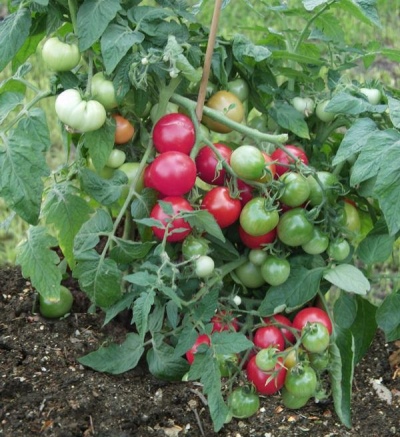
- Authors: Ignatova S. I., Gorshkova N. S., Tereshonkova T. A. (Agrofirma Partner LLC)
- Year of approval: 2003
- Name synonyms: Winter cherry F1
- Category: hybrid
- Growth type: indeterminate
- Appointment: fresh consumption, for whole fruit preservation
- Ripening period: early
- Ripening time, days: 95
- Growing conditions: for film greenhouses, for greenhouses
- Marketability: high
For cherry tomato lovers, Winter Cherry is a great choice. The plant can be grown in the garden beds or in the garden, which, however, will be an excellent decoration. This is a very beautiful view with descending cascades of abundantly fruiting clusters hung with bright berries.
Breeding history
Employees of Agrofirma Partner, famous for their work, took part in the creation of the hybrid:
- Tereshonkova T.A .;
- Ignatova S.I .;
- Gorshkova N.S.
The crop was approved for cultivation in 2003. Synonym for the name - Winter cherry F1.
Description of the variety
Standard indeterminate hybrid Winter cherry grows up to two meters. Differs in weak foliage. In this case, the leaves are of medium size, the color is green. The structure of the inflorescences is intermediate. The first is laid between 9 and 11 sheets. Further, they are formed every 3 leaves. One brush is laid from 18 to 20 berries. It is very convenient to harvest with a whole branch at once. Of the positive qualities of the variety, one can single out such as:
- high productivity;
- early maturation;
- possibility of transportation;
- impeccable commercial qualities;
- great fruit taste;
- rather long storage.
As for the cons, many people don't like the fact that the plants need to be formed.
The main qualities of the fruit
Cherry tomatoes Unripe winter cherries have a traditionally green color, while the stalk has a dark green spot. Ripe berries are red, round in shape, each tomato is 30 grams, with a smooth skin.
Taste characteristics
Taste cherry tomatoes Winter cherries are sweet. They are distinguished by dense pulp, fleshy.
Ripening and fruiting
The described cherry tomatoes ripen in the early stages, that is, 90-95 days after the seeds sprout. Harvesting can be scheduled for mid-July.
Yield
Cherry Winter cherry is a fairly productive variety. Indicators such as 9.7 kilograms from one square are noted, but one bush gives up to 3 kilograms of fruit.
The timing of planting seedlings and planting in the ground
Seeds can be sown already in the first decade of April, or rather, from 1 to 8. Loose turf soil is suitable for planting seeds. It can be planted in the ground from 4 to 8 June. Seed material is sealed to a depth of one and a half centimeters, then it is sprinkled with fine-grained soil and lightly tamped. Seedling care includes:
- weekly hardening;
- a pick when two leaves appear;
- fertilization with Agricola or Krepysh solution.

Growing tomato seedlings is an extremely important process, because it largely depends on whether the gardener can harvest at all. All aspects must be taken into account, from seedbed preparation to planting in the ground.
Landing scheme
It is worth planting cherry tomato bushes for growing, taking into account the planting scheme - from 2 to 3 plants on an area of 1 square meter.

Growing and caring
Cherry tomato variety Winter cherry is considered to be quite unpretentious in cultivation and care, therefore the cultivation process does not have any difficulties and features. The culture will bear fruit well on sandy and loamy soil, even if the fertile layer is rather small.
To make sure that the seedlings can be planted in the beds, you need to look at the number of leaves - there should be 7 or 8 of them, as well as one ovary on a branch. This usually happens 45 days after sowing the seeds. Tomato bushes should be placed at a distance of half a meter from each other, and about 60 centimeters should remain between the beds. Leaving is pretty simple:
- watering - 3 times a week (5 l / bush);
- a layer of mulch - 8 centimeters;
- top dressing - monthly in the process of flowering, fruit ovary, ripening.
The culture is traditionally grown using two-stem technology. It is very important not to forget to regularly weed the beds, loosen the soil and use organic matter for fertilization. Before the flowering period and at the beginning of the ripening of the first berries, it is necessary to feed the Winter cherry with rotted manure or plant residues, adding them to the soil during watering or loosening.




A plant needs different micronutrients at each stage of growth. All fertilizers can be divided into two groups: mineral and organic. Folk remedies are often used: iodine, yeast, bird droppings, eggshells.
It is important to observe the rate and period of feeding. This also applies to folk remedies and organic fertilizers.
Disease and pest resistance
Considering that Winter cherry is an early variety, the culture manages to bear healthy fruits even before outbreaks of various viral diseases. If the plant is sick, it is necessary to use treatment with copper-containing fungicides. For preventive purposes, a one-time treatment with insecticides will be sufficient, but you can also use tincture of wormwood and garlic.


Growing regions
In general, the early ripe hybrid Winter cherry is quite unpretentious, since it was bred specifically for the northern regions, where the climate is unstable and ordinary tomatoes do not have time to bear fruit before the cold weather.

























































































